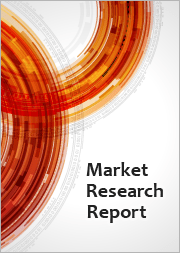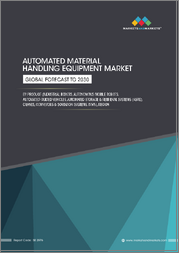
|
시장보고서
상품코드
1636390
병렬 로봇 시장 : 유형별, 최종 사용자별, 지역별(2025-2033년)Parallel Robots Market by Type (Double Arms, Multiple Arms), End User (Food and Beverages, Medical, Electronics, and Others), and Region 2025-2033 |
||||||
세계의 병렬 로봇 시장 규모는 2024년 10억 440만 달러에 달했습니다. IMARC 그룹은 향후 시장이 2033년까지 19억 7,100만 달러에 이를 전망이며, 2025년부터 2033년까지 7.39%의 성장률(CAGR)을 보일 것으로 예측했습니다. 바로 먹을 수 있는(RTE) 식품 수요 증가, 첨단 기술의 통합, 제조업에서의 병렬 로봇의 사용 증가 등이 시장을 견인하는 주요 요인입니다.
병렬 로봇은 병렬 매니퓰레이터라고도 불리며 컴퓨터로 제어되는 여러 직렬 체인으로 하나의 플랫폼을 지원하는 기계 시스템입니다. 다관절 로봇이며, 로봇의 베이스와 하나 이상의 매니퓰레이터 암의 이동에 유사한 메커니즘을 사용합니다. 평행하게 움직이는 복수의 축을 가지며, 거치형의 구동 장치와 기어를 갖추고 있습니다. 이 로봇은 동일한 평행 동역학 체인에 의해 고정베이스에 연결된 이동 플랫폼으로 구성됩니다. 또한 선형 액추에이터, 직류(DC) 모터, 기어박스, 다리용 리드 스크류를 갖추고 있습니다. 병렬 로봇은 일반적으로 픽 앤 플레이스 용도에 사용되며, 고정밀도, 고속, 안정성, 암 강성 향상 및 사이클 타임 단축을 실현하기 위해 전 세계적으로 수요가 증가하고 있습니다.
병렬 로봇 시장 동향 :
병렬 로봇은 식품 및 음료 업계에서 다양한 식품 및 음료 포장에 사용됩니다. 이는 바쁜 라이프스타일과 개인의 구매력 확대로 인한 RTE(Ready-to-Eat) 제품에 대한 수요 증가와 함께 세계 시장 성장을 지원하는 주요 요인 중 하나가 되고 있습니다. 또한 전자상거래 산업에서는 노동 집약적인 수작업 아이템 피킹 작업을 수행하기 위해 병렬 로봇이 채택되었습니다. 이것은 온라인 쇼핑에 대한 선호도가 증가함에 따라 시장 성장을 뒷받침합니다. 게다가, 다양한 산업의 제조 장비에서 자동화의 요구가 증가하고 있는 것도 시장에 긍정적인 영향을 미치고 있습니다. 이 외에도 병렬 로봇은 제약 업계에서 작업 부하를 최소화하고 포장 중에 의약품이 오염되는 것을 방지하는 용도를 발견했습니다. 또한 안전성, 신뢰성 향상, 경제적 절약으로 이어집니다. 또한 병원에서 수술이 증가함에 따라 정확도를 높이고 인위적 실수를 없애고 의료 종사자와 환자의 위생 상태를 개선하는 병렬 로봇에 대한 수요가 증가하고 있습니다. 이 외에도 사물인터넷(IoT), 에지컴퓨팅, 인공지능(AI), 머신러닝(ML), 자연언어처리(NLP)를 병렬 로봇에 통합하여 시장 성장을 강화하고 있습니다. 또한 Industry 4.0의 새로운 추세와 전자 장비에 대한 수요가 증가함에 따라 시장에 밝은 전망이 생깁니다.
이 보고서에서 다루는 주요 질문
- 세계의 병렬 로봇 시장은 지금까지 어떻게 추이하고 향후 어떻게 추이할 것인가?
- 세계의 병렬 로봇 시장에서 촉진요인, 억제요인 및 기회는?
- 주요 지역 시장은?
- 가장 매력적인 병렬 로봇 시장은 어느 국가인가?
- 유형별 시장 내역은?
- 최종 사용자별 시장 내역은?
- 세계 병렬 로봇 시장의 경쟁 구도는?
- 세계의 병렬 로봇 시장에서 주요 업체 및 기업은?
목차
제1장 서문
제2장 조사 범위 및 조사 방법
- 조사의 목적
- 이해관계자
- 데이터 소스
- 1차 정보
- 2차 정보
- 시장 추정
- 상향식 접근
- 하향식 접근
- 조사 방법
제3장 주요 요약
제4장 서문
- 개요
- 주요 업계 동향
제5장 세계의 병렬 로봇 시장
- 시장 개요
- 시장 실적
- COVID-19의 영향
- 시장 예측
제6장 시장 내역 : 유형별
- 더블 암
- 시장 동향
- 시장 예측
- 멀티암
- 시장 동향
- 시장 예측
제7장 시장 내역 : 최종 사용자별
- 식품 및 음료
- 시장 동향
- 시장 예측
- 의료
- 시장 동향
- 시장 예측
- 일렉트로닉스
- 시장 동향
- 시장 예측
- 기타
- 시장 동향
- 시장 예측
제8장 시장 내역 : 지역별
- 북미
- 미국
- 캐나다
- 아시아태평양
- 중국
- 일본
- 인도
- 한국
- 호주
- 인도네시아
- 기타
- 유럽
- 독일
- 프랑스
- 영국
- 이탈리아
- 스페인
- 러시아
- 기타
- 라틴아메리카
- 브라질
- 멕시코
- 기타
- 중동 및 아프리카
제9장 촉진요인, 억제요인 및 기회
- 개요
- 성장 촉진요인
- 성장 억제요인
- 기회
제10장 밸류체인 분석
제11장 Porter's Five Forces 분석
- 개요
- 구매자의 협상력
- 공급기업의 협상력
- 경쟁도
- 신규 진입업자의 위협
- 대체품의 위협
제12장 가격 분석
제13장 경쟁 구도
- 시장 구조
- 주요 기업
- 주요 기업 프로파일
- ABB Ltd.
- Bekannter(Yuyao) Robotics Technology Co. Ltd.
- FANUC Corporation
- Hiwin Corporation
- Kawasaki Heavy Industries Ltd.
- Kuka AG
- Omron Corporation
- Penta Robotics
- Siasun Robot & Automation Co. Ltd.
- Yaskawa America Inc.(Yaskawa Electric Corporation)
The global parallel robots market size reached USD 1,004.4 Million in 2024. Looking forward, IMARC Group expects the market to reach USD 1,971.0 Million by 2033, exhibiting a growth rate (CAGR) of 7.39% during 2025-2033. The increasing demand for ready-to-eat (RTE) food products, the integration of advanced technologies, and the rising use of parallel robots in manufacturing industry represent some of the key factors driving the market.
Parallel robots, also known as parallel manipulators, are mechanical systems that relies on several computer-controlled serial chains to support a single platform. They are articulated robots that use similar mechanisms for the movement of the robot on its base and one or more manipulator arms. They have multiple axes that move in parallel and have stationary drives and gears. They comprise a mobile platform connected to a fixed base by a set of identical parallel kinematic chains. They also involve a linear actuator, direct current (DC) motor, gear box, and lead screw for the legs. As they are commonly used in pick and place applications and offer high precision and speed and increased stability and arm rigidity with faster cycle times, the demand for parallel robots is catalyzing across the globe.
Parallel Robots Market Trends:
Parallel robots are used in the food and beverage (F&B) industry for the packaging of different food products and drinks. This, coupled with the increasing demand for ready-to-eat (RTE) products on account of hectic lifestyles and the expanding purchasing power of individuals, represents one of the major factors supporting the market growth around the world. Moreover, parallel robots are employed in the e-commerce industry to perform labor-intensive manual item picking tasks. This, in confluence with the rising preferences for online shopping, is favoring the market growth. In addition, the growing need for automation in the manufacturing units of various industry verticals is influencing the market positively. Apart from this, parallel robots find applications in the pharmaceutical industry to minimize workloads and prevent medicines from contamination during packaging. They also improve safety, reliability, and financial savings. Furthermore, the increasing number of surgical procedures in hospitals is catalyzing the demand for parallel robots to increase precision, eliminate human error and improve hygienic conditions among healthcare professionals and patients. Besides this, the integration of the Internet of Things (IoT), edge computing, artificial intelligence (AI), machine learning (ML), and natural language processing (NLP) in parallel robots are strengthening the growth of the market. Additionally, the emerging trend of Industry 4.0 and the growing demand for electronic devices are creating a positive outlook for the market.
Key Market Segmentation:
Type Insights:
- Double Arms
- Multiple Arms
End User Insights:
- Food and Beverages
- Medical
- Electronics
- Others
Regional Insights:
- North America
- United States
- Canada
- Asia-Pacific
- China
- Japan
- India
- South Korea
- Australia
- Indonesia
- Others
- Europe
- Germany
- France
- United Kingdom
- Italy
- Spain
- Russia
- Others
- Latin America
- Brazil
- Mexico
- Others
- Middle East and Africa
- The report has also provided a comprehensive analysis of all the major regional markets that include North America (the United States and Canada), Asia Pacific (China, Japan, India, South Korea, Australia, Indonesia, and others), Europe (Germany, France, United Kingdom, Italy, Spain, Russia, and others), Latin America (Brazil, Mexico, and others), and the Middle East and Africa. According to the report, Asia Pacific was the largest market for parallel robots. Some of the factors driving the Asia Pacific parallel robots market included the rising automation, the advent of Industry 4.0, the increasing use of parallel robots in e-commerce industry, etc.
Competitive Landscape:
- The report has also provided a comprehensive analysis of the competitive landscape in the global parallel robots market. Detailed profiles of all major companies have also been provided. Some of the companies covered include ABB Ltd., Bekannter (Yuyao) Robotics Technology Co. Ltd., FANUC Corporation, Hiwin Corporation, Kawasaki Heavy Industries Ltd., Kuka AG, Omron Corporation, Penta Robotics, Siasun Robot & Automation Co. Ltd., Yaskawa America Inc. (Yaskawa Electric Corporation), etc. Kindly note that this only represents a partial list of companies, and the complete list has been provided in the report.
Key Questions Answered in This Report:
- How has the global parallel robots market performed so far and how will it perform in the coming years?
- What are the drivers, restraints, and opportunities in the global parallel robots market?
- What are the key regional markets?
- Which countries represent the most attractive parallel robots markets?
- What is the breakup of the market based on the type?
- What is the breakup of the market based on the end user?
- What is the competitive structure of the global parallel robots market?
- Who are the key players/companies in the global parallel robots market?
Table of Contents
1 Preface
2 Scope and Methodology
- 2.1 Objectives of the Study
- 2.2 Stakeholders
- 2.3 Data Sources
- 2.3.1 Primary Sources
- 2.3.2 Secondary Sources
- 2.4 Market Estimation
- 2.4.1 Bottom-Up Approach
- 2.4.2 Top-Down Approach
- 2.5 Forecasting Methodology
3 Executive Summary
4 Introduction
- 4.1 Overview
- 4.2 Key Industry Trends
5 Global Parallel Robots Market
- 5.1 Market Overview
- 5.2 Market Performance
- 5.3 Impact of COVID-19
- 5.4 Market Forecast
6 Market Breakup by Type
- 6.1 Double Arms
- 6.1.1 Market Trends
- 6.1.2 Market Forecast
- 6.2 Multiple Arms
- 6.2.1 Market Trends
- 6.2.2 Market Forecast
7 Market Breakup by End User
- 7.1 Food and Beverages
- 7.1.1 Market Trends
- 7.1.2 Market Forecast
- 7.2 Medical
- 7.2.1 Market Trends
- 7.2.2 Market Forecast
- 7.3 Electronics
- 7.3.1 Market Trends
- 7.3.2 Market Forecast
- 7.4 Others
- 7.4.1 Market Trends
- 7.4.2 Market Forecast
8 Market Breakup by Region
- 8.1 North America
- 8.1.1 United States
- 8.1.1.1 Market Trends
- 8.1.1.2 Market Forecast
- 8.1.2 Canada
- 8.1.2.1 Market Trends
- 8.1.2.2 Market Forecast
- 8.1.1 United States
- 8.2 Asia-Pacific
- 8.2.1 China
- 8.2.1.1 Market Trends
- 8.2.1.2 Market Forecast
- 8.2.2 Japan
- 8.2.2.1 Market Trends
- 8.2.2.2 Market Forecast
- 8.2.3 India
- 8.2.3.1 Market Trends
- 8.2.3.2 Market Forecast
- 8.2.4 South Korea
- 8.2.4.1 Market Trends
- 8.2.4.2 Market Forecast
- 8.2.5 Australia
- 8.2.5.1 Market Trends
- 8.2.5.2 Market Forecast
- 8.2.6 Indonesia
- 8.2.6.1 Market Trends
- 8.2.6.2 Market Forecast
- 8.2.7 Others
- 8.2.7.1 Market Trends
- 8.2.7.2 Market Forecast
- 8.2.1 China
- 8.3 Europe
- 8.3.1 Germany
- 8.3.1.1 Market Trends
- 8.3.1.2 Market Forecast
- 8.3.2 France
- 8.3.2.1 Market Trends
- 8.3.2.2 Market Forecast
- 8.3.3 United Kingdom
- 8.3.3.1 Market Trends
- 8.3.3.2 Market Forecast
- 8.3.4 Italy
- 8.3.4.1 Market Trends
- 8.3.4.2 Market Forecast
- 8.3.5 Spain
- 8.3.5.1 Market Trends
- 8.3.5.2 Market Forecast
- 8.3.6 Russia
- 8.3.6.1 Market Trends
- 8.3.6.2 Market Forecast
- 8.3.7 Others
- 8.3.7.1 Market Trends
- 8.3.7.2 Market Forecast
- 8.3.1 Germany
- 8.4 Latin America
- 8.4.1 Brazil
- 8.4.1.1 Market Trends
- 8.4.1.2 Market Forecast
- 8.4.2 Mexico
- 8.4.2.1 Market Trends
- 8.4.2.2 Market Forecast
- 8.4.3 Others
- 8.4.3.1 Market Trends
- 8.4.3.2 Market Forecast
- 8.4.1 Brazil
- 8.5 Middle East and Africa
- 8.5.1 Market Trends
- 8.5.2 Market Breakup by Country
- 8.5.3 Market Forecast
9 Drivers, Restraints, and Opportunities
- 9.1 Overview
- 9.2 Drivers
- 9.3 Restraints
- 9.4 Opportunities
10 Value Chain Analysis
11 Porters Five Forces Analysis
- 11.1 Overview
- 11.2 Bargaining Power of Buyers
- 11.3 Bargaining Power of Suppliers
- 11.4 Degree of Competition
- 11.5 Threat of New Entrants
- 11.6 Threat of Substitutes
12 Price Analysis
13 Competitive Landscape
- 13.1 Market Structure
- 13.2 Key Players
- 13.3 Profiles of Key Players
- 13.3.1 ABB Ltd.
- 13.3.1.1 Company Overview
- 13.3.1.2 Product Portfolio
- 13.3.1.3 Financials
- 13.3.1.4 SWOT Analysis
- 13.3.2 Bekannter (Yuyao) Robotics Technology Co. Ltd.
- 13.3.2.1 Company Overview
- 13.3.2.2 Product Portfolio
- 13.3.3 FANUC Corporation
- 13.3.3.1 Company Overview
- 13.3.3.2 Product Portfolio
- 13.3.3.3 Financials
- 13.3.3.4 SWOT Analysis
- 13.3.4 Hiwin Corporation
- 13.3.4.1 Company Overview
- 13.3.4.2 Product Portfolio
- 13.3.4.3 Financials
- 13.3.5 Kawasaki Heavy Industries Ltd.
- 13.3.5.1 Company Overview
- 13.3.5.2 Product Portfolio
- 13.3.5.3 Financials
- 13.3.5.4 SWOT Analysis
- 13.3.6 Kuka AG
- 13.3.6.1 Company Overview
- 13.3.6.2 Product Portfolio
- 13.3.6.3 Financials
- 13.3.6.4 SWOT Analysis
- 13.3.7 Omron Corporation
- 13.3.7.1 Company Overview
- 13.3.7.2 Product Portfolio
- 13.3.7.3 Financials
- 13.3.7.4 SWOT Analysis
- 13.3.8 Penta Robotics
- 13.3.8.1 Company Overview
- 13.3.8.2 Product Portfolio
- 13.3.9 Siasun Robot & Automation Co. Ltd.
- 13.3.9.1 Company Overview
- 13.3.9.2 Product Portfolio
- 13.3.9.3 Financials
- 13.3.10 Yaskawa America Inc. (Yaskawa Electric Corporation)
- 13.3.10.1 Company Overview
- 13.3.10.2 Product Portfolio
- 13.3.1 ABB Ltd.
Kindly, note that this only represents a partial list of companies, and the complete list has been provided in the report.



















